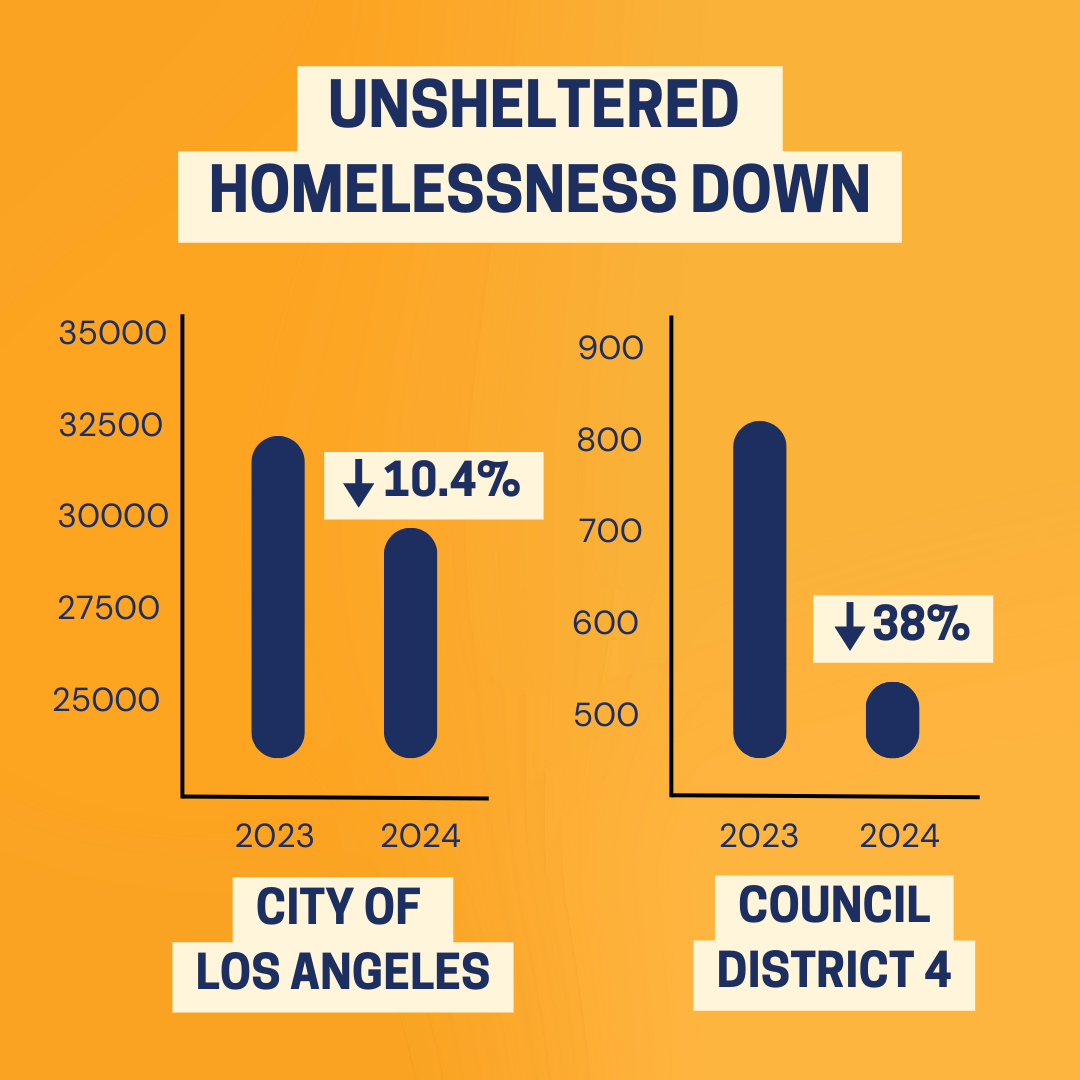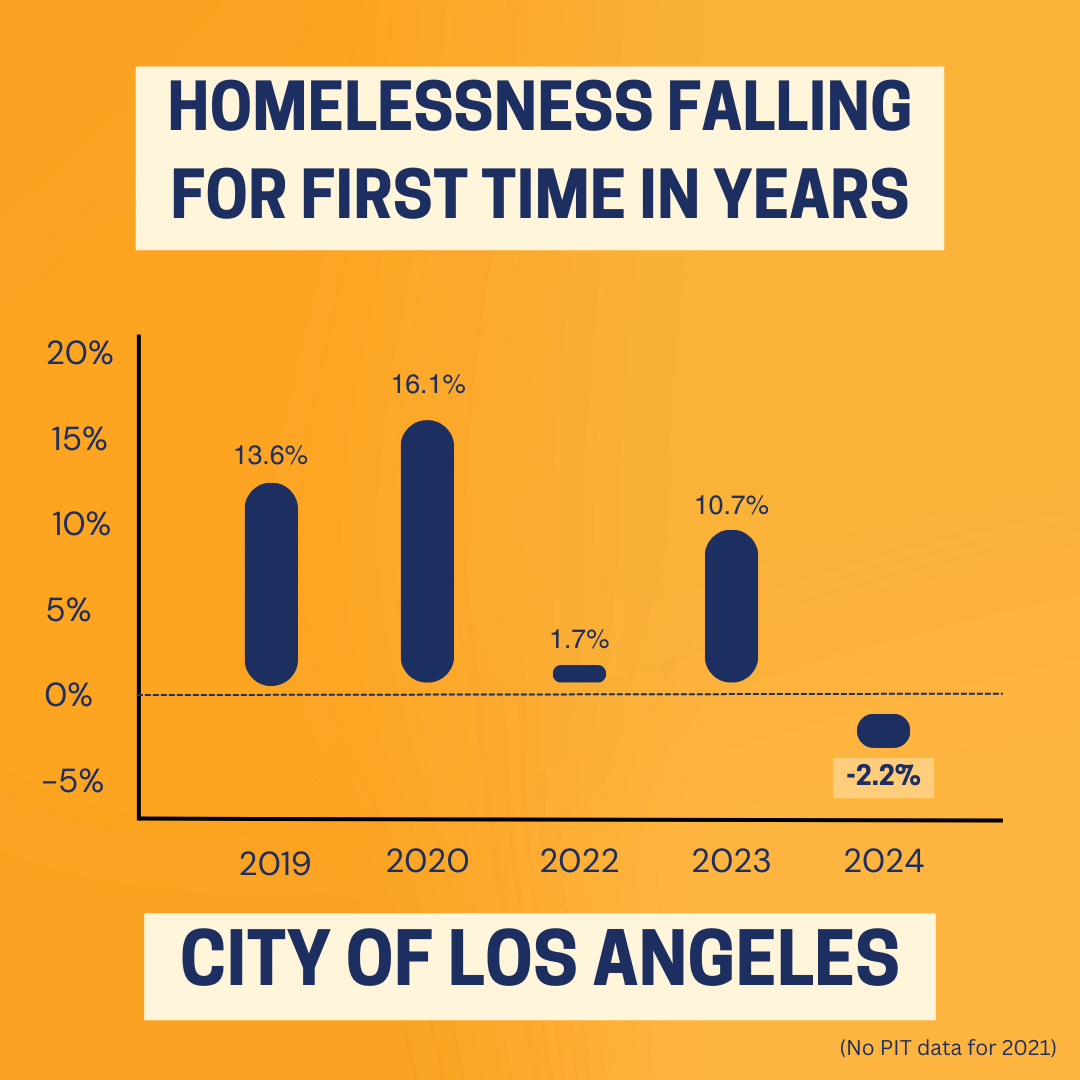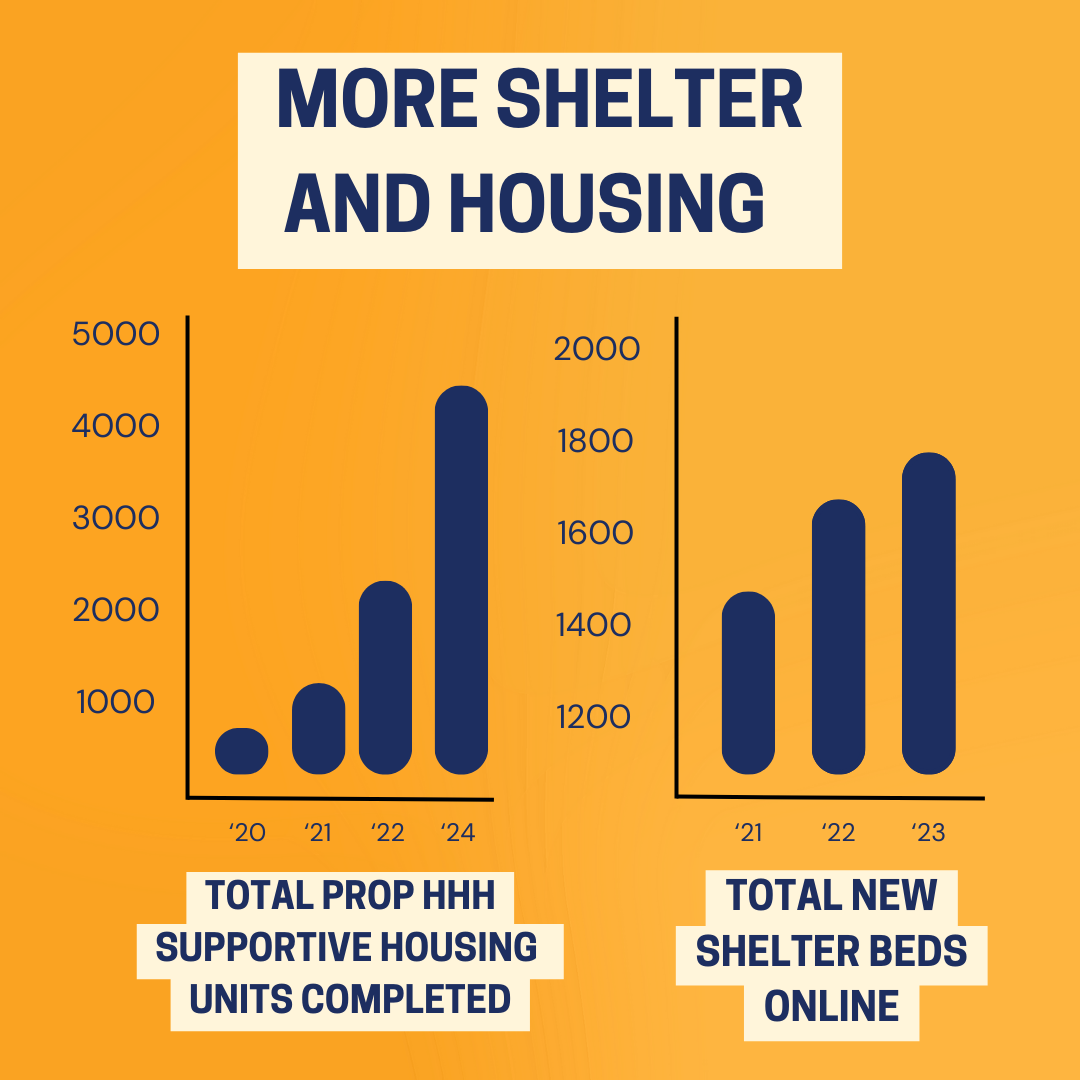LA's Homeless Count: The Big Numbers and What They Mean
The data from LA’s 2024 Homeless Count were released today – and the results are major news.
The big headline: the City of LA saw its biggest reduction in the number of people living on the street since we first started gathering this data in 2013.
The count takes place annually at the beginning of each year, and represents an approximation of how many people are experiencing homelessness at that point in time.
Thousands of volunteers and staff roam the streets, counting cars, vans, RVs, tents, makeshift encampments, and unsheltered individuals. These figures combine to give us a total number representing “unsheltered homelessness.” People who are living in shelters are also tallied as a separate data set, representing “sheltered homelessness.” Then they’re all added together to provide a figure for total homelessness in LA County and the smaller jurisdictions within it.
The annual Count is mandated by HUD, and helps determine how much federal funding we get.
Here are my main takeaways from this year’s numbers!
Unsheltered homelessness in the City of LA (the number of people living on the streets) is down 10.4% compared to last year – a huge drop.
This is the biggest drop in unsheltered homelessness the City of LA has seen since the Homeless Count started including this data in 2013. A double-digit reduction in the number of people living on our city’s streets is really wonderful news for LA — and our prospects for ending the most pressing crisis we face.
In my district, Council District 4, we saw an approximately 38% drop in unsheltered homelessness – the largest drop of any district – as well as the lowest raw numbers of cars, vans, RVs and tents in the entire city.
My staff and I are very excited and grateful to see so much improvement in just one year – especially because our district did not accomplish this decrease by shoving people into other parts of the city. Our focus has always been on bringing people indoors into shelter and into safety, and it’s wonderful to see that approach getting results.
Overall homelessness in LA City fell for the first time since 2018 – by 2.2%.
An overall reduction in homelessness, even a small one, is truly welcome news after six consecutive years of increases. The humanitarian crisis on the streets has been on a dire trajectory in recent years, including several years of double digit increases. This year’s count results indicate that we’re finally moving in a different direction.
What did LA do differently to reduce homelessness after so many years of increases?
The numbers show that the citywide drop in the numbers of people living on the street was driven by bringing more people indoors into shelter and housing, including many into new units and shelter beds that we added in the last year.
How do we know that?
Sheltered homelessness rose significantly – by 18% – as we added many new shelter beds.
Los Angeles had virtually no city-run shelter options as recently as 2018. But over the last half-decade, we’ve been growing our investments in congregate shelters, Tiny Homes, hotel shelters, and other facilities to bring people indoors.
Last year, Mayor Bass also added a significant number of new shelter beds under her signature Inside Safe initiative, which places people living in encampments into hotels and motels around the city. Shelter beds increased by about 1,000 from the previous year’s total – a marked increase given that we only have about 17,000 beds overall in the City of LA – and our sheltered homelessness counts have grown accordingly.
This is a good thing! When our sheltered homelessness figures grow, that means we both added more beds and filled those beds. We’ll come back to how we did that later on.
We also added new permanent housing.
We had our all-time biggest number of placements in permanent housing in 2023 – almost 28,000 people were helped into permanent housing. That’s an increase of more than 5,000 from 2022, and comes after several years of plateauing housing numbers.
More people got into permanent housing in part because we opened up more units. Nearly 2,000 new units funded by LA’s 2016 Prop HHH ballot measure came online this year, as did units purchased through the state’s Homekey program, which allowed cities to buy apartments and hotels for homeless housing. We also utilized federal emergency housing vouchers to match people to more than 3,000 long-term housing units.
It’s not complicated: when you provide more places for people to go, fewer people are on the streets. Los Angeles was able to add significantly to both our shelter and housing totals this past year. That’s the biggest reason why this Homeless Count showed fewer people on the street.
Encampment resolution is effective, and Inside Safe did it citywide.
In recent years, council offices, including ours, have utilized encampment resolution to address street homelessness effectively. This is a method that focuses outreach efforts on a single encampment and offers shelter to every single person at that site.
Shortly after Mayor Bass took office, she announced the launch of the Inside Safe program, which made encampment resolution a citywide strategy for addressing homelessness. Her office targeted encampments across the entire city, and made motel and hotel rooms available for people experiencing homelessness.
Historically, LA has handled homelessness (and a lot of other issues) on a district-by-district basis, allowing each City Councilmember a lot of discretion in deciding how they want to approach the problem. This district-by-district approach causes a lot of issues, which I’ve discussed at length in other places.
But through the Mayor’s efforts, she was able to take an effective approach to housing people citywide.
We added new protections for tenants.
This year’s reduction in unsheltered homelessness is even more striking when you consider that it took place in the same year as the end of LA’s eviction moratorium.
The lifting of the moratorium, which had been in place for more than three years and protected tenants from eviction over unpaid rent, was predicted to cause a massive number of Angelenos to lose their homes, and force many people into homelessness. One study predicted that ending the moratorium too early and without protections could force more than 100,000 households onto the street.
But while eviction cases did rise this year after the moratorium was lifted, an “eviction tsunami” did not materialize. Why? Los Angeles took major steps to protect tenants with new and permanent protections.
At the beginning of 2023, LA passed the following new tenant protections:
Universal “just cause” eviction protections, meaning that landlords must provide a valid cause for evicting a tenant (and can’t just force a tenant to leave because they want to charge a new tenant more money).
A floor on evictable rent debt, meaning that tenants can’t be evicted if they owe less than one month’s fair market rent.
Relocation assistance for rent-gouged tenants of non-rent controlled units equivalent to three months of fair market rent – intended to be a disincentive against landlords hiking up rents even when it’s legal for them to do so.
All of these interventions combined to bring thousands of people indoors, keep thousands more in their homes, and make significant progress in our fight against homelessness in Los Angeles.
So what’s next?
All in all, this year’s reduction in homelessness was the product of hard work and aggressive intervention.
But this is absolutely not a moment to take our foot off the gas. Unfortunately, LA is currently facing some fiscal and social challenges that could roll back our progress if we don’t keep moving our work forward.
Here’s what LA has to do to build on our success.
Centralize Operations and Improve Accountability
Over just the last few years, LA built out an entire outreach network, thousands of shelter beds, and thousands of supportive housing units. Again, we had virtually none of any of these things as recently as 2016.
We accumulated these resources by using funds from city dollars, local ballot measures, the state, and the federal government to build programs that aggressively intervene against homelessness across the city. Inside Safe was just the most recent example: it was very well-funded and quickly built-out due to a rightful sense of urgency.
But this system is expensive, and LA and California are entering a period of financial insecurity. In order to continue our progress, we must make our systems more efficient and ensure our leaders, departments, and staff are held accountable for meeting our ambitious goals.
We can’t accept a reduction in services due to a likely reduction in funding – and we don’t have to. We can streamline our services to help them operate more effectively, even at a lower cost.
One way to do that: improve how we gather data to ensure that every dollar we spend is maximized. We can work to ensure that multiple case managers aren’t all working with the same client while other people on the street go underserved, and that every single shelter bed and housing unit is being filled quickly.
Centralizing our homelessness response would also go a long way toward improving our efficiency. Homelessness response at the city level is not housed in any one office or department – it’s spread across multiple elected offices and departments. Placing supervisorial powers and accountability in the hands of a centralized entity — one armed with all the data needed for accountability — would help all of our city homelessness programs work even better.
Add More Street-Level Mental Health Services and Drug Treatment
As we’re getting more people off the street, conditions for people who remain there are in many ways getting worse. Drugs are rampant in encampments, and we still see a crushing number of overdose deaths every year. And while a significant percentage of people living in encampments self-report mental health issues, not enough of our street-level outreach teams are equipped with mental health professionals.
But there’s reason for hope that LA will see more services on the streets this year. A recent legal settlement has compelled the County of LA, which oversees our public health and mental health systems, to expand drug treatment and mental health outreach while adding more beds to its system. Better partnership with the County to ensure that these new investments reach people living on our city’s streets is essential to our success.
Thanks for reading and for taking an interest in how we can end homelessness in LA! I’m looking forward to digging deeper into these numbers and sharing more about LA’s work on homelessness in the coming year.




